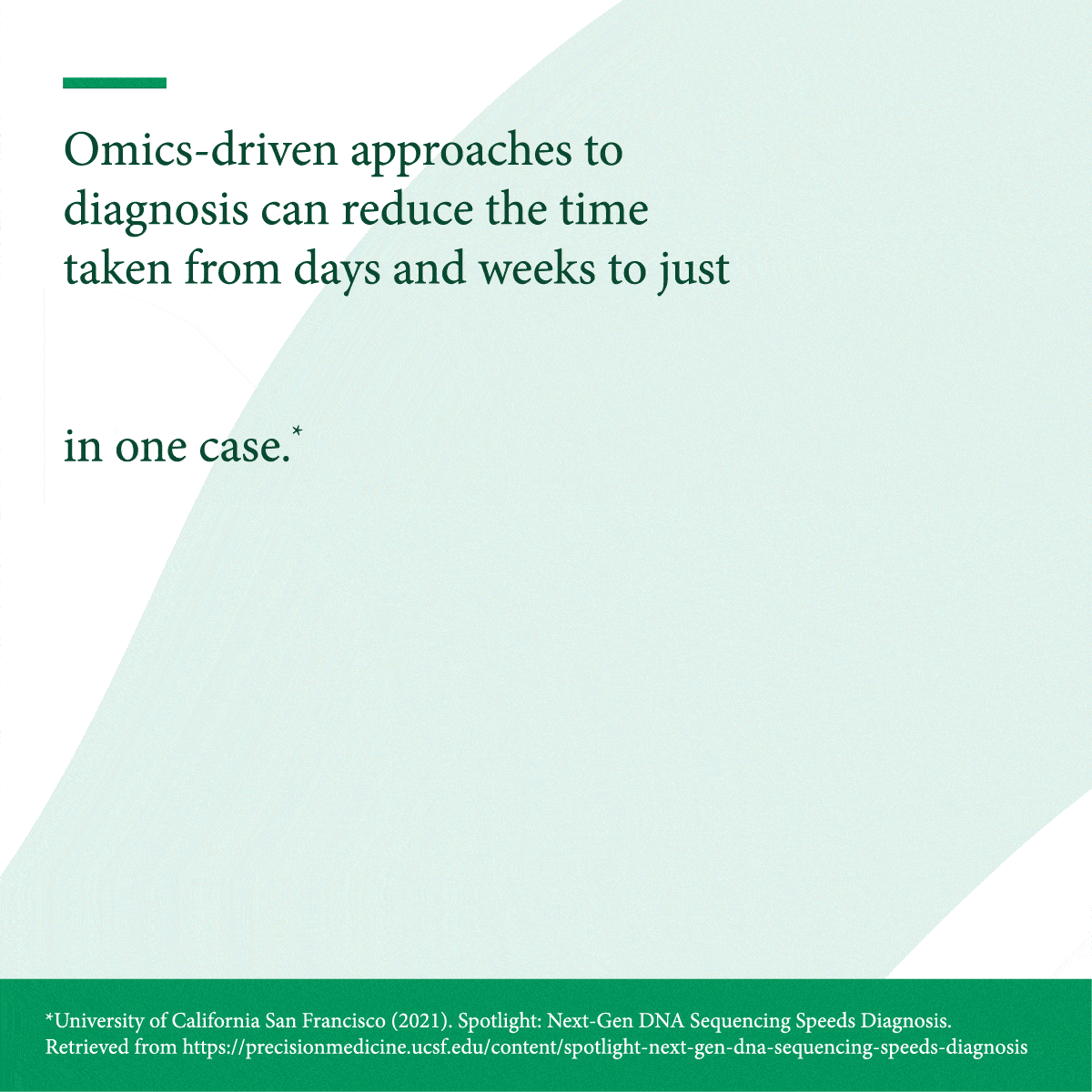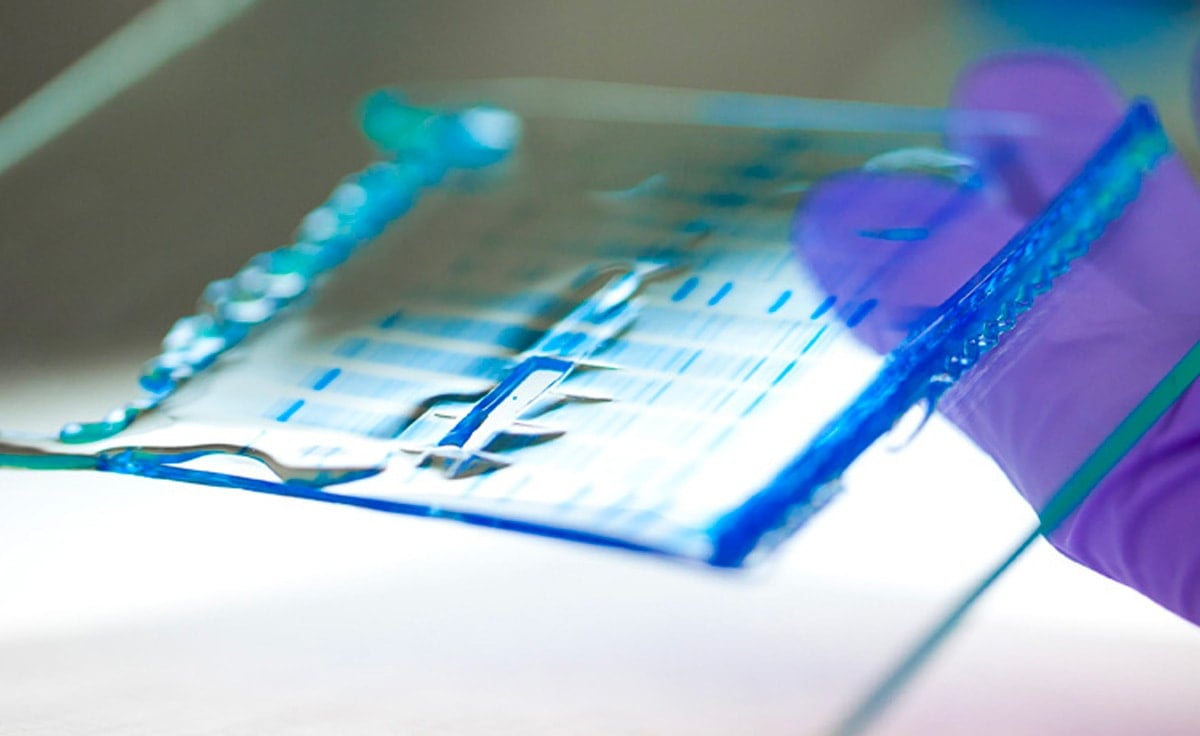In the medical world, smaller is always better. And one field in particular is helping to zero in on a new level of care. “Omics” is used to describe the next generation of personalised diagnostics in the lab, with the potential of treating patients at a molecular level1 — instead of the traditional, symptom-driven practice2 of medicine. This opens up a more personalised approach to precision medicine, influencing every stage of diagnostics1 from preventive testing and early intervention, to diagnosing hereditary diseases in the womb and in newborns, to predicting adverse reactions to certain medications.
But the concept of precision diagnosis is not new3. For more than a century, blood typing3 has informed the way we approach blood transfusions. What has changed is the unprecedented amount of genetic information3 now available and the development of powerful computational tools to analyse them, eventually giving rise to new methods of characterising patients and more accurate, personalised diagnoses1 — by taking their clinical, molecular, and genomic factors2 into account.
In the treatment of Duchenne Muscular Dystrophy (DMD), for instance, the accurate characterisation of genetic mutations can help to establish the prognosis and determine eligibility for these treatments.1

Omics-driven approaches to diagnosis can reduce the time taken from days and weeks to just 96 minutes in one case.
Omics Beyond Genomics
Part of omics is trying to decipher how an individual’s genomes6, their environment and biological history can impact their risk for certain diseases and influence their response to medical treatments. This is the fundamental question precision diagnostics seeks to answer. Pathophysiological traits unearthed by omics will allow physicians to prescribe individualised treatments and better predict population health to aid policymakers.
“Omics is really seeing the entire collection of molecules that make up you. Basically, it’s your DNA, it’s your proteins, it’s all your metabolites, and such,” explained Professor Michael Snyder7, chair of genetics at Stanford University.
By offering a holistic view of a patient’s condition, advances in omics technologies are supporting the transition to precision diagnostics — from the detection of genes4 (genomics), mRNA (transcriptomics), proteins (proteomics), epigenomic factors (epigenomics) to metabolites (metabolomics).
Doing More with Less
The application of omics technologies is especially helpful8 for patients suffering from late stages of chronic, acute, complex2 and novel infectious diseases. (In short, everything from diabetes to strokes, cancer to COVID-19). In such cases, it is critical to provide timely, personalised treatment.
For example, Next-Generation Sequencing (NGS)9 has contributed substantially to advances in omics10. NGS has replaced Sanger sequencing of single gene fragments and is able to generate information on millions of DNA and RNA sequences in just a single test. It is also able to detect rare genetic variants and Single Nucleotide Polymorphisms (SNPs). As NGS can be applied to both tissue and blood samples, it is invaluable when insufficient tumour material is available for sequential single biomarker tests.
Prof Jee Hyun Kim, a breast cancer specialist and Director of the Precision Medicine Centre at Seoul National University Bundang Hospital, South Korea, says that NGS can explain a particular prognosis or identify a matched therapy for a specific indication.
This helps to eliminate the need for patients suffering from debilitating symptoms due to rare, undiagnosed conditions to undergo multiple tests (a “diagnostic Odyssey” in medical parlance). “What we need are digital tools, algorithms and AI that can match patients to a clinical trial in a manner that is unified and country-wide, so that fewer resources and less manpower is needed,” says Professor Kim Jee-Hyun.

The Hospital of the Future
Digital solutions2 may hold the key to boosting the implementation of mainstream predictive and precision diagnostics, including utilising machine learning and Artificial Intelligence (AI) for multimodal data aggregation, multifactor examination, and building a database of clinical predictors for decision support.
In the future, Professor Kim envisions AI-driven digital platforms quickly pairing drugs and clinical trials for patients based on their genomic data collected during diagnosis, ensuring that every patient is matched for the best treatment outcomes — benefitting both patients and clinicians in the process. “Together with our patients,” Professor Kim says, “we’ll be looking into these systems to select options suggested by AI.”
Dr Jan-Gowth Chang12, professor and director of laboratory medicine at the centre for precision medicine and epigenome research centre of China Medical University Hospital, agrees. Dr Chang believes that the confluence of big data, AI and smart diagnostic algorithms could make omics even more relevant in the future. “We are just beginning to integrate NGS and clinical data, with two groups collecting clinical and image data and incorporating NGS, SNP or big data,” he shares.
Diagram Dialogues
Subscribe to our podcast to hear expert insights from the world of diagnostics
References:
1University of California San Francisco (2021). ‘Omics Medicine. Retrieved from https://precisionmedicine.ucsf.edu/omics-medicine
2Ahmed, Z. (2020) Practicing Precision Medicine with Intelligently Integrative Clinical and Multi-Omics Data Analysis. Retrieved from https://humgenomics.biomedcentral.com/articles/10.1186/s40246-020-00287-z
3Collins, F., Varmus, H. A New Initiative on Precision Medicine. Retrieved from https://www.nejm.org/doi/10.1056/NEJMp1500523
4Morello, G., Salomone, S., D’agata, V., Conforti, F., Cavallaro, S. (2020). From Multi-Omics Approaches to Precision Medicine in Amyotrophic Lateral Sclerosis. Retrieved from https://www.frontiersin.org/articles/10.3389/fnins.2020.577755/full
5Suzuki, N., Akiyama, T., Warita, H., Aoki, M. (2020). Omics Approach to Axonal Dysfunction of Motor Neurons in Amyotrophic Lateral Sclerosis (ALS). Retrieved from https://www.frontiersin.org/articles/10.3389/fnins.2020.00194/full
6Lau, E., Wu, J. (2018). Omics, Big Data, and Precision Medicine in Cardiovascular Sciences. Circulation Research, 122(9), 1165 — 1168. Retrieved from https://www.ncbi.nlm.nih.gov/pmc/articles/PMC6488521/
7NASA Video. (2016). (Video 1 of 8) Introduction to Omics: 360 Degree View of You. YouTube. Retrieved from https://www.youtube.com/watch?v=m7X6mugpijQ
8University of California San Francisco (2021). Spotlight: Next-Gen DNA Sequencing Speeds Diagnosis. Retrieved from https://precisionmedicine.ucsf.edu/content/spotlight-next-gen-dna-sequencing-speeds-diagnosis
9Tan, D. (2020). Next-Generation Sequencing (NGS) Drives Precision Oncology in Singapore. Retrieved from https://www.labinsights.com/get-inspired/content/next-generation-sequencing-ngs-drives-precision-oncology-singapore
10Kulski, J. (2016). Next-Generation Sequencing — An Overview of the History, Tools, and “Omic” Applications. Retrieved from https://www.intechopen.com/books/next-generation-sequencing-advances-applications-and-challenges/next-generation-sequencing-an-overview-of-the-history-tools-and-omic-applications
11Jee-Hyun, K. (2021). NGS and Precision Oncology in South Korea: Insights from Prof Kim Jee-Hyun. Retrieved from https://www.labinsights.com/get-inspired/content/ngs-and-precision-oncology-south-korea-insights-prof-kim-jee-hyun
12Chang, J., Hsieh, J. (2021). NGS and Precision Oncology in Taiwan: Insights from Dr Jan-Gowth Chang and Dr Jason CH Hsieh. Retrieved from https://www.labinsights.com/get-inspired/content/ngs-and-precision-oncology-taiwan-insights-dr-jan-gowth-chang-and-dr-jason-ch-hsieh














